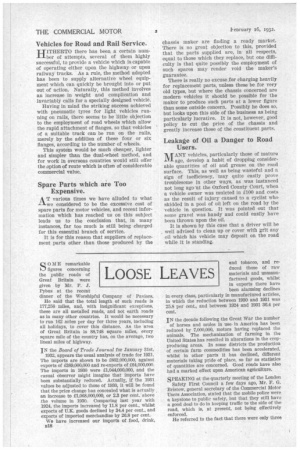Practical Proofs of Performance
Page 35

Page 36

If you've noticed an error in this article please click here to report it so we can fix it.
Our hopes that this, series would prove Of value have been fully confirmed by our readers' letters, and the data obtained in the tests have been referred to in many quarters as providing the most authoritative information upon comparative performance. Furthermore, users have been influenced in their purchases by the results of our tests.
There are various features which must be borne in mind when making use of the information provided. First, each test is over an average distance ranging from about 60 to 100 miles, so that conditions are varied, and not purely local and those most favourable to any particular machine. Secondly, the number of vehicles tested is so great that averages can be drawn for various classes and individual perforni, ances compared therewith. Thirdly, the tests apply to ahnost every class of vehicle, ranging from three-wheeled parcelcars weighing some 5 cwt., to large multi-wheelers scaling some 22 tons, and include propulsion by petrol engines, oil engines and steam prime movers. Fourthly, all data are obtained by the use of simple instruments handled by experts.
The terms of reference are, in all cases, intelligible to the man in the street and, not only can results be compared for similar chassis, but the figures given can be visualized by the man who has little idea of mechanical matters.
Whilst these tests appeal to the non-technical as well as to the more experienced vehicle -user, particulars are given which enable further, _calculations to be made on the part of the expert. Obviously, space considerations preclude the publication of as much data as we should desire, but the particulars given can serve as the basis of further investigation ; for example, the engine torque and gear ratios, etc., provide the technician with details which enable him to arrive at the maximum gradient climbable, and so forth.
These tests provide information which can be utilized to the financial advantage of vehicle operators and buyers ; after ally the costs question is ...of paramount importance.
THE COMMERCIAL MOTOR Vehicles for Road and Rail Service.
HITEIERTO there has been a certain number of attempts, several of them highly successful, to provide a vehicle which is capable of operating either upon the highway or upon railway tracks. As a rule, the method adopted has been to supply alternative wheel equipment which can quickly be brought into or put out of action. Naturally, this method involves an increase in weight and complication and invariably calls for a specially designed vehicle.
Having in mind the striking success achieved with pneumatic tyres for light vehicles running on rails, there seems to be little objection to the employment of road wheels which allow the rapid attachment of flanges, so that vehicles of a suitable track can be run on the rails, merely by the addition of these four or six flanges, according to the number of wheels.
This system would be much cheaper, lighter and simpler than the dual-wheel method, and for work in overseas countries would still offer the option of route which is often of considerable commercial value.
Spare Parts which are Too • Expensive.
AT various times we have alluded to what we considered to be the excessive cost of spare parts for motor vehicles, and recent information which has reached us on this subject leads us to the conclusion that, in many instances, far too much is still being charged for this essential branch of service.
It is for this reason that suppliers of replacement parts other than those produced by the chassis maker are finding a ready market. There is no great objection to this, provided that the parts supplied are, in all respects, equal to those which they replace, but one difficulty Is that quite possibly the employment of such spares may render void the maker's guarantee.
There is really no excuse for charging heavily for replacement parts, unless these be for very old types, but where the chassis concerned are modern vehicles it should be possible for the maker to produce such parts at a lower figure than some outside concern. Possibly he does so, but looks upon this side of the business as being particularly lucrative. It is not, however, good policy to cut the price of the chassis and greatly increase those of the constituent parts.
Leakage of Oil a Danger to Road Users.
MANY vehicles, particularly those of mature age, develop a habit of dropping considerable quantities of oil and grease on the road surface. This, as well as being wasteful and a sign of inefficiency, may quite easily prove troublesome in other ways, as was instanced not long ago at the Oxford County Court, when a vehicle owner was mulcted in £100 and costs as the result of injury caused to a cyclist who skidded in a pool of oil left on the road by the vehicle in question. It was pointed out that some gravel was handy and could easily have been thrown upon the oil.
It is shown by this case that a driver will be well advised to clean up or cover with grit any oil which his vehicle may deposit on the road while it is standing.




































































































